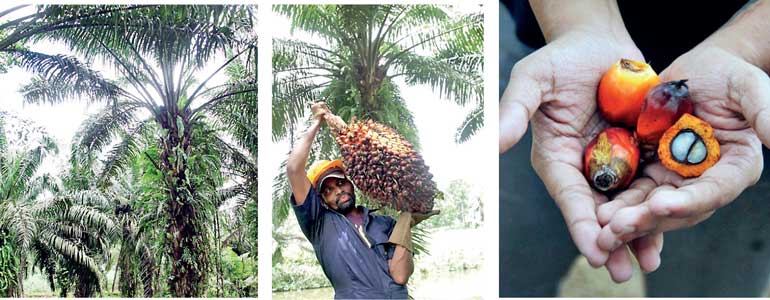Friday Dec 13, 2024
Friday Dec 13, 2024
Thursday, 30 November 2017 00:00 - - {{hitsCtrl.values.hits}}

Oil palm profits expanded exponentially over the past year with the four regional plantation companies (RPCS) engaged in the business recording turnover growth of 44.2% Year-on-Year (YoY) up to Rs. 3.95 billion, while profits within the sector rose by 66.6% YoY to Rs. 2.29 billion at the end of the 2016/17 financial year, according to the most recent information released by the Planters Association of Ceylon (PA).
Out of the 20 RPCs operating in Sri Lanka’s plantations sector, four – Watawala Plantations with 3,157 hectares, Namunukula Plantations with 2,041 hectares, Elpitiya Plantations with 1,571 hectares and Agalawatte Plantations with 1,311 hectares - have already established commercially viable oil palm plantations.
By way of comparison, revenue generated by the tea businesses of these same four RPCs reached Rs. 7.62 billion during the same period, while profits hit Rs. 75.2 million. Similarly, the rubber sector of these RPCs – exempting Watawala Plantations which is not engaged in the rubber business - recorded turnover of Rs. 1.04 billion but ultimately resulted in losses of Rs. 180.7 million during the same period.
Now home to oil palm plantations spanning 8,500 hectares, the continuing efforts by Sri Lanka’s RPCs to establish a thriving oil palm business in the country is aligned with the Sri Lankan Government’s ambitious goal of planting 20,000 hectares of oil palm.
Commending the remarkable performances of Sri Lanka’s oil palm producing Regional Plantation Companies (RPCs) over the recently concluded financial year, the Planters’ Association of Ceylon (PA) issued a statement calling for greater facilitation of engagement, investment with a gradual focus towards value addition in the oil palm sector.
“We commend the pioneering efforts of all Sri Lankan RPCs in relation to their proactive diversifications into the oil palm sector. We are confident that sustainably grown oil palm plantations hold the potential to rejuvenate the wider plantation industry.
“Particularly given the unprecedented and growing international demand for oil palm, the sector is anticipated to generate strong profitability over the medium term. In that regard, we encourage all plantation industry stakeholders to explore new ways to get engaged in the oil palm sector, either through sustainable cultivation or value-addition,” stated PA Chairman Sunil Poholiyadde.
Over the recent past, more RPCs have also been making important progress in terms of oil palm diversifications, with Kegalle Plantations now working to plant 300 hectares having already established oil palm nurseries during the previous year. Similarly, Bogawantalawa Tea, Kotagala, Lalan Rubber and Horana Plantations each launched their own oil palm projects during the past year and anticipate substantial contributions to revenue from this emerging segment over the medium-long term.
Unfortunately, despite the remarkable potential for this crop to substantially improve the financial performance of Sri Lankan RPCs, and in turn, for those employed in the plantation sector, oil palm continues to face resistance at the local government and provincial council level.
“While the higher levels of Government have been supportive, unfortunately there is a lot of misinformation and outright lies being circulated among lower levels that is leading to serious challenges for RPCs seeking to make diversifications into oil palm. For our part, we are working to educate the general public about the tremendous potential that sustainably cultivated oil palm has to drastically improve the lives of those working in the sector, while providing invaluable support for RPCs that continue to face stiff challenges in tea and rubber cultivation,” Poholiyadde explained.
Internationally, palm oil remains a ubiquitous part of modern life, being commonly utilised as a primary ingredient in food, soaps, cosmetics, candles, bio-fuel, animal feed and many other consumer products. While approximately 64.5 million tonnes of palm oil was produced globally in 2016, demand for the commodity has outpaced global production.
First established in Sri Lanka in the late 1960s, growing demand for sustainably grown oil palm ensures that the commodity commands strong prices while the effort required to cultivate the crop is much lower and less labour intensive than either tea or rubber with the field level cost of production standing at Rs. 20 per kg of fresh fruit bunches (FFB) as against a selling price of approximately Rs. 40, enabling healthy profit margins for sustainable producers.
Leading performances during the 2016/17 financial year was Watawala Plantations, whose substantial oil palm sector segment posted outstanding growth to close the year with revenue of Rs. 2.16 billion, compared to Rs. 1.5 billion in the 2015/16 financial year and profits before tax (PBT) of Rs. 1.13 billion, improving significantly over the previous year’s Rs. 702.8 million.
Oil palm businesses also recorded considerable growth in other oil palm producing RPCs with Namunukula posting revenue of Rs. 898 million against a previous Rs. 566 million, while gross profits from the segment stood at Rs. 602 million in FY2016/17, compared to Rs. 347 million in FY2015/16.
The contribution of oil palm to Elpitiya Plantations revenue increased from Rs. 408 million to Rs. 619.6 million, generating a profit of Rs. 396.1 million by the end of the period in review, compared to Rs. 202.2 million in the previous financial year. Meanwhile, Agalawatte Plantations posted revenue of Rs. 275.1 million compared to Rs. 265.4 million, leading to profits of Rs. 169.8 million, compared to Rs. 127.3 million during the previous year.